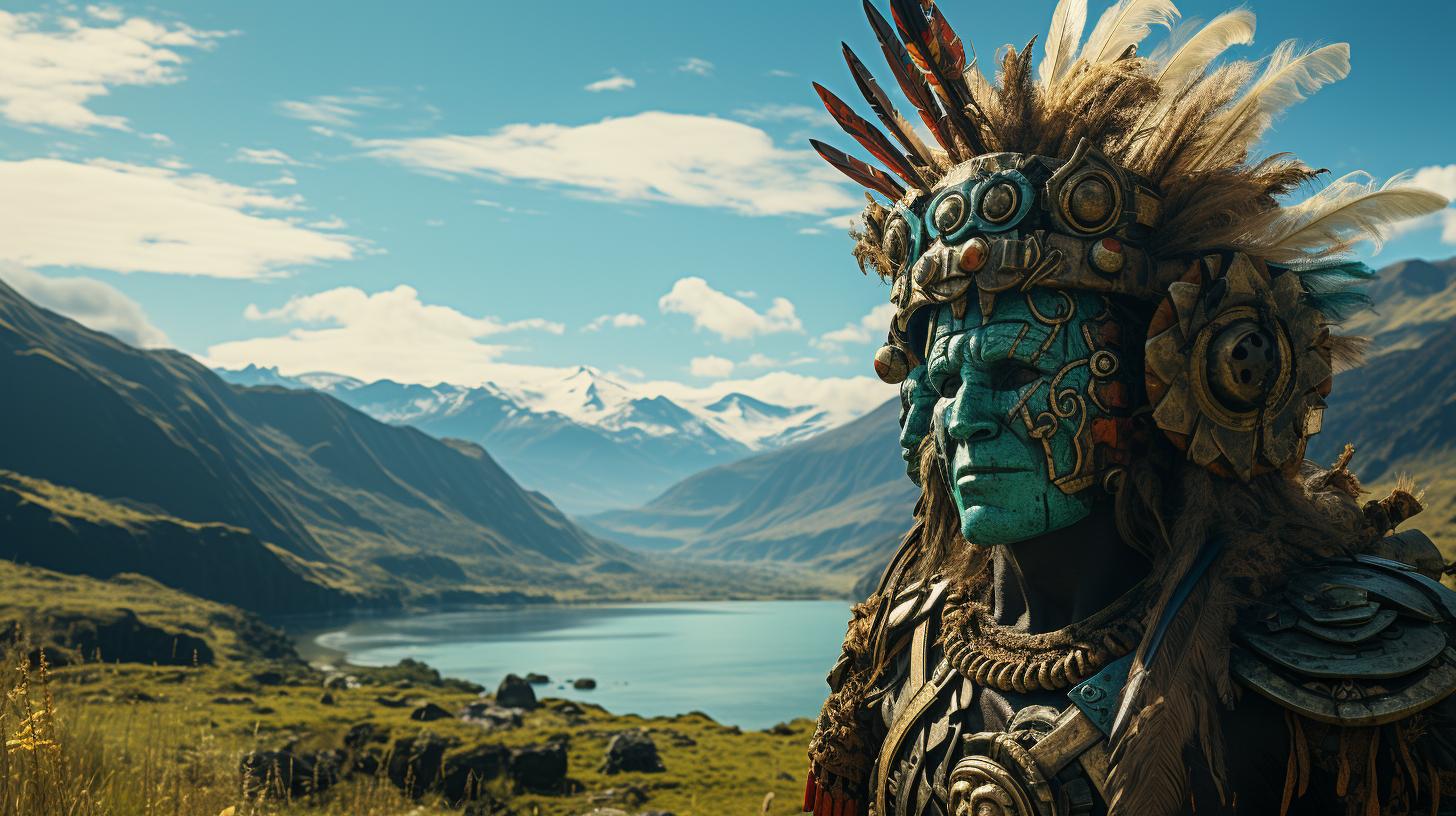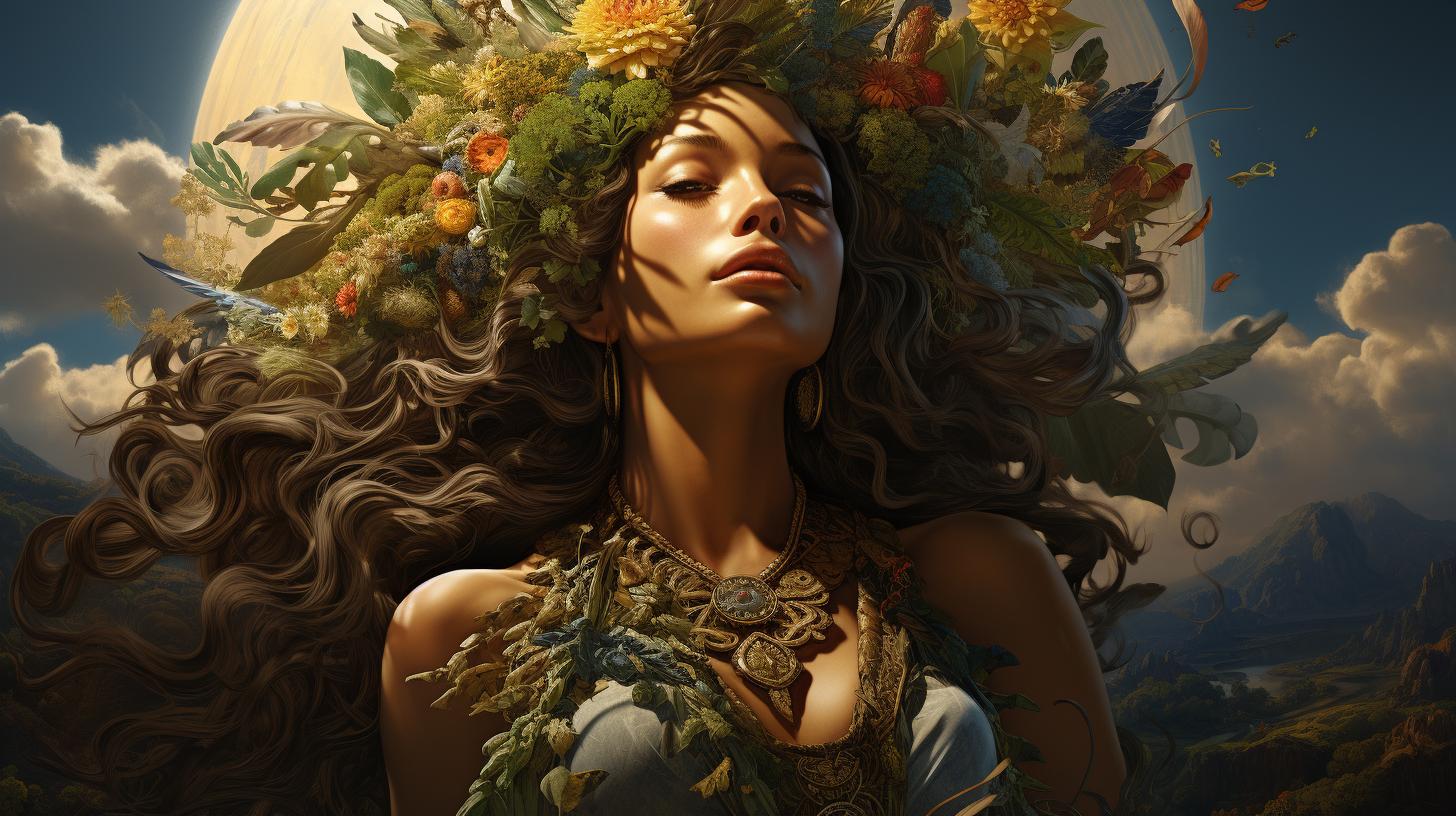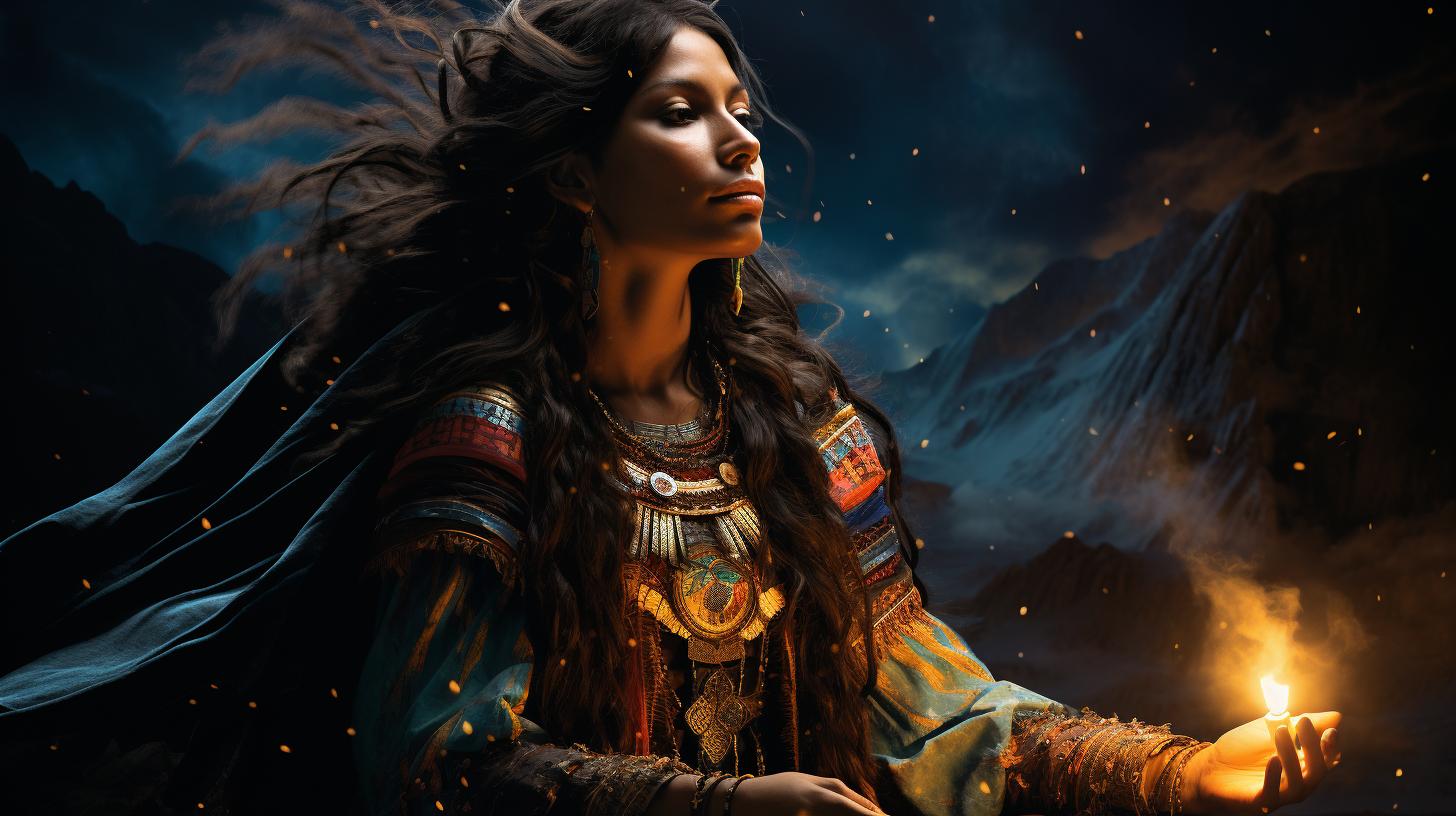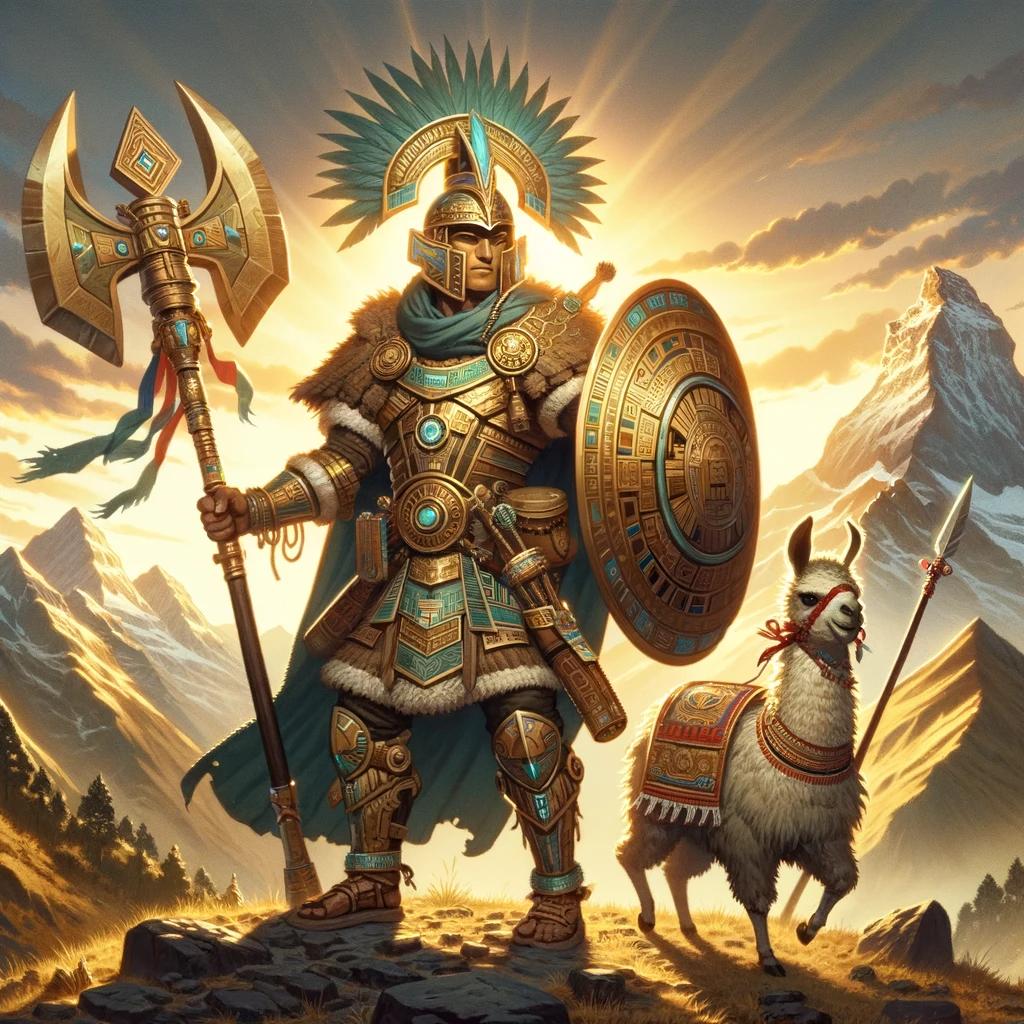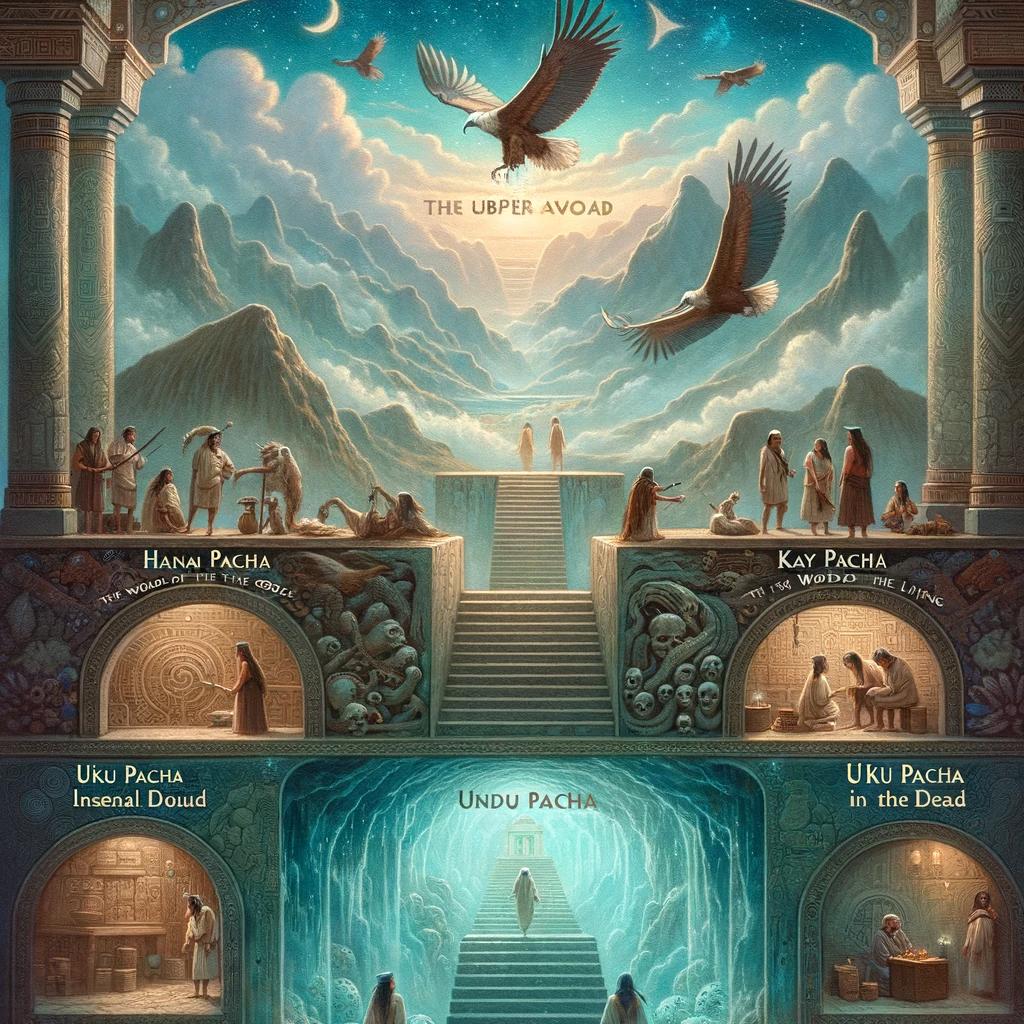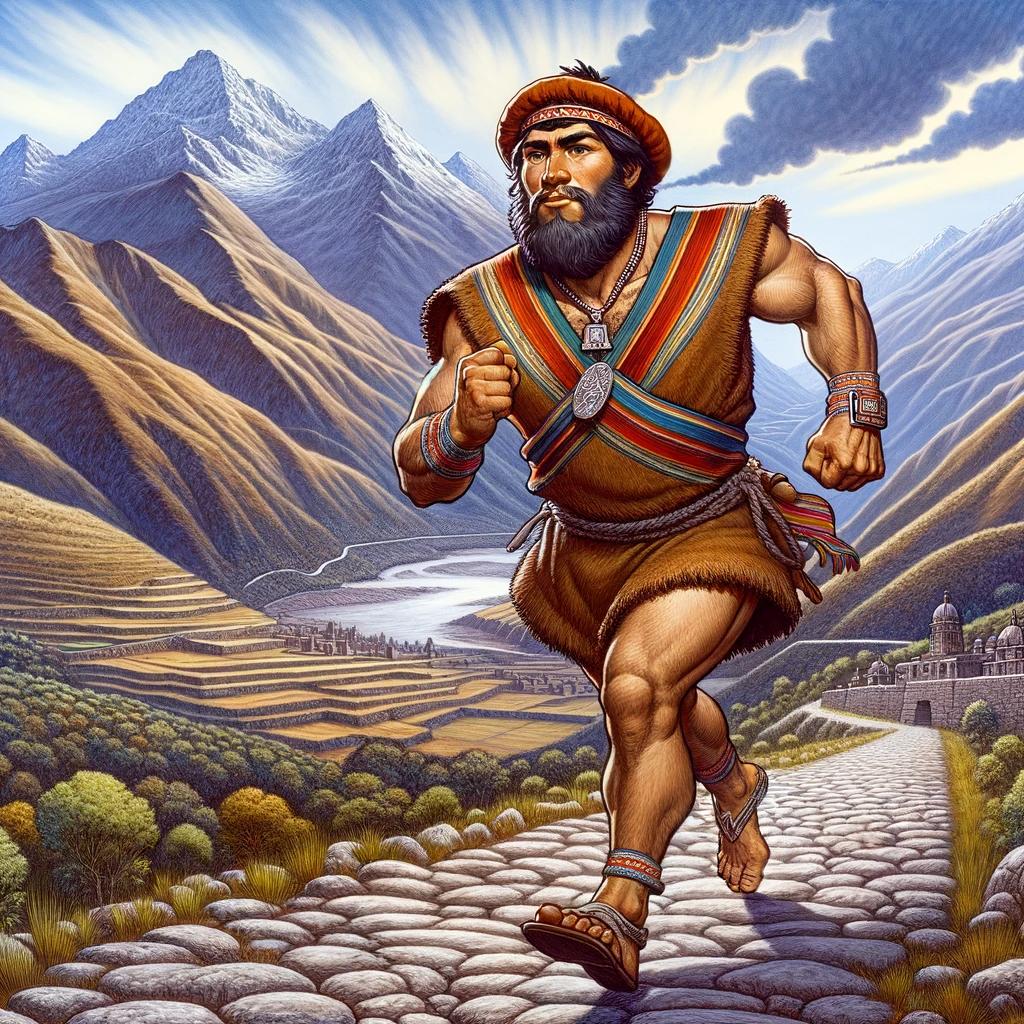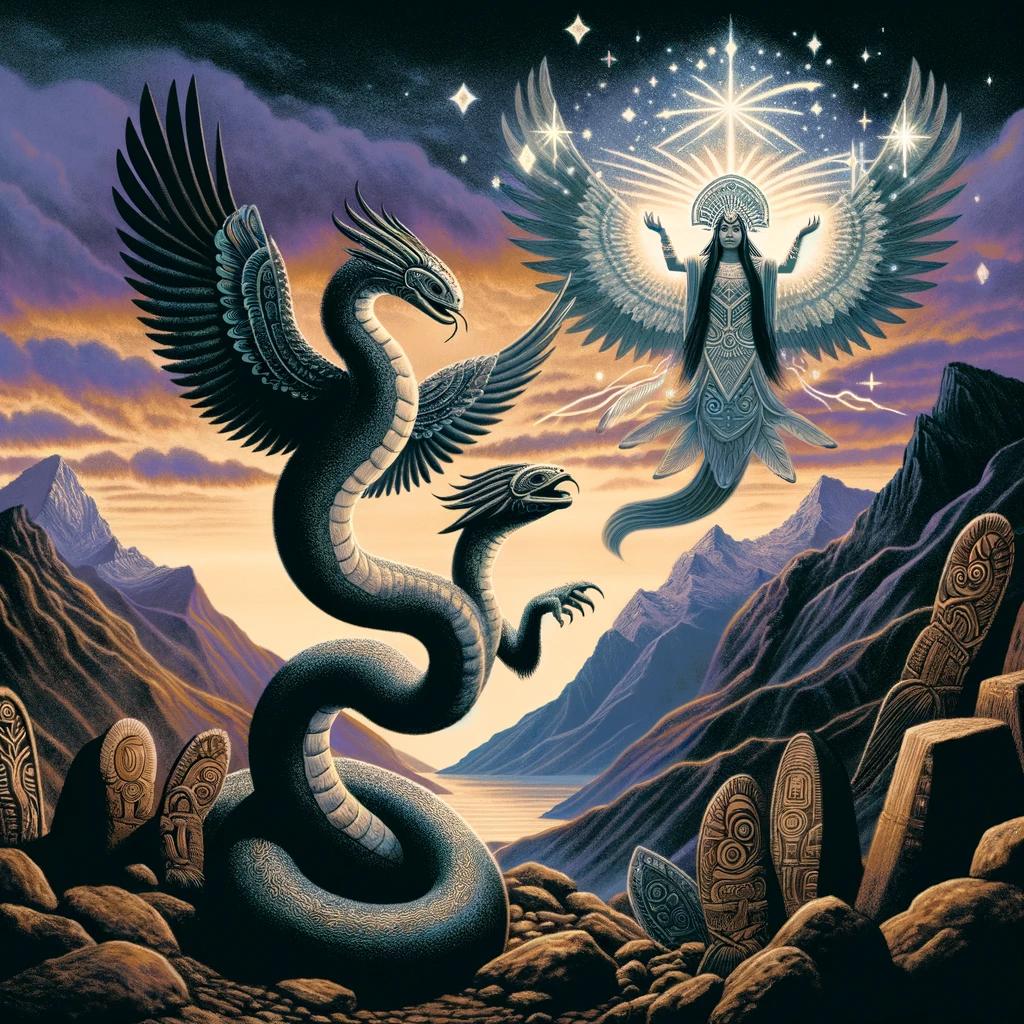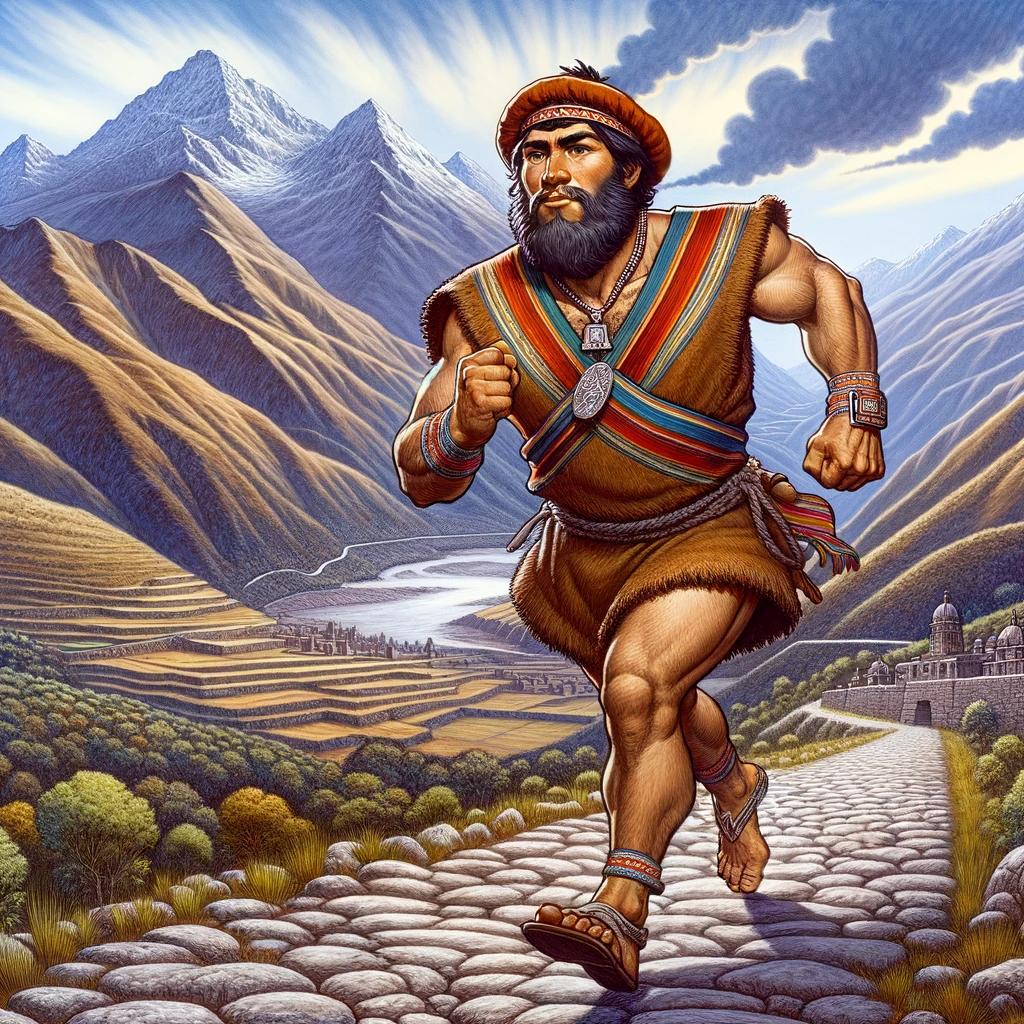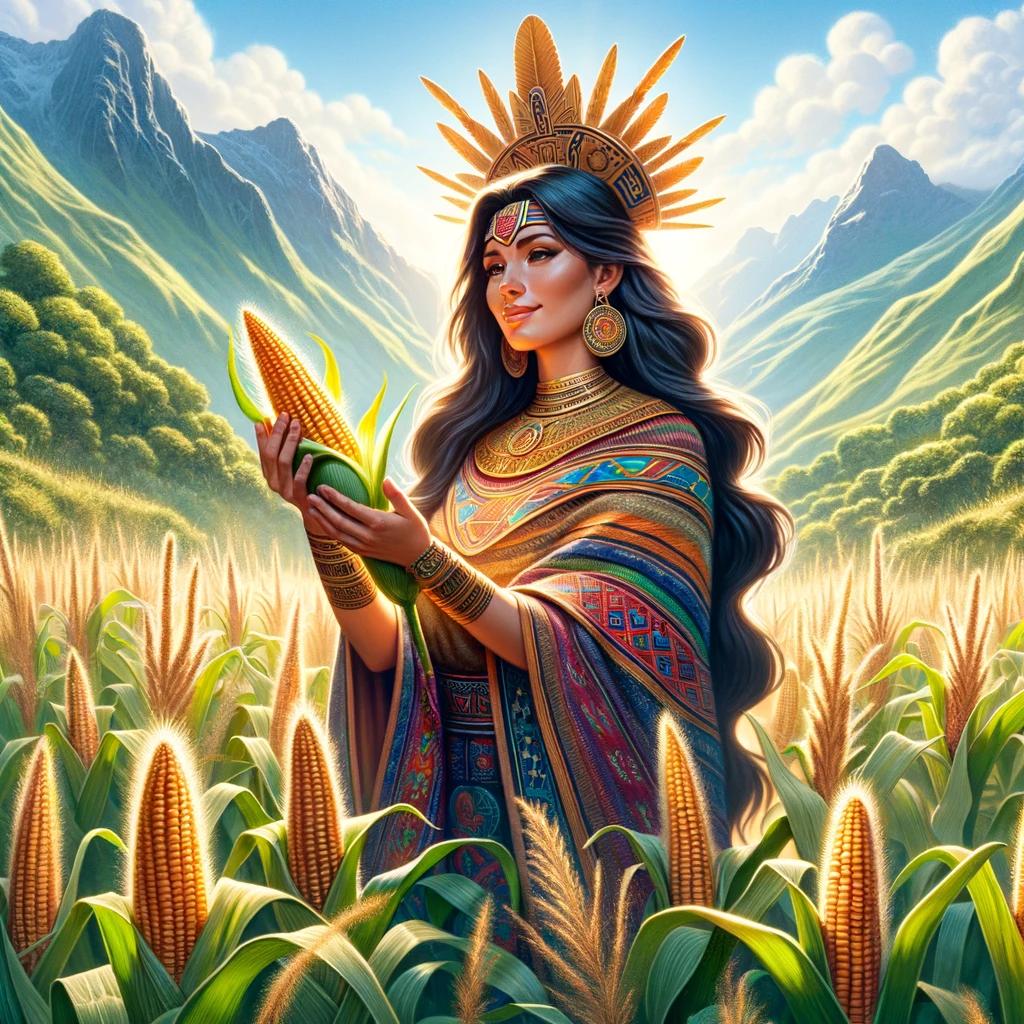Inca God Viracocha: Unveiling the Ancient Deity’s Mysteries
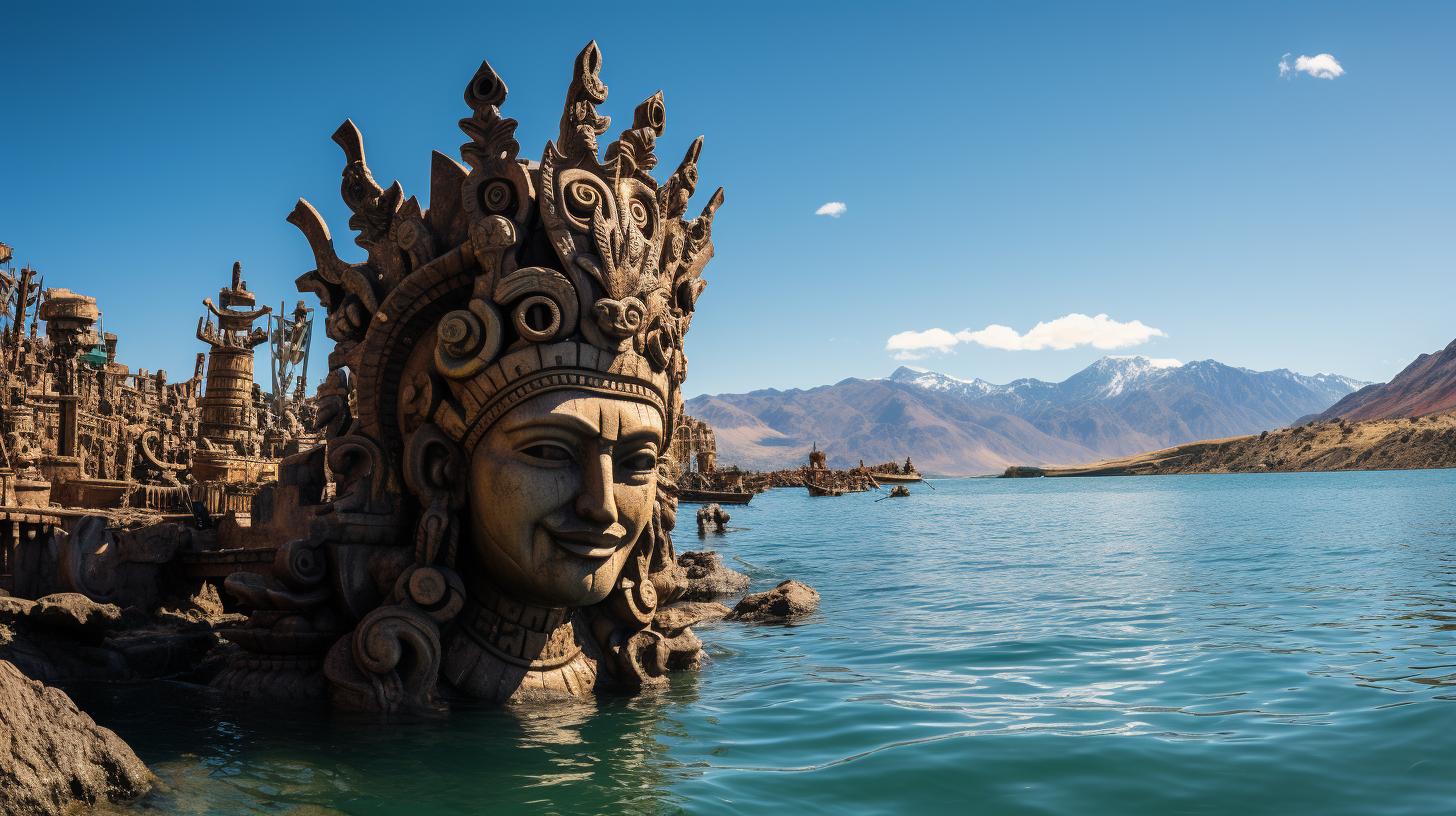
The Inca god Viracocha holds a significant place in ancient Peruvian mythology and history. Linked to the creation of the Inca civilization, Viracocha’s name carries symbolic meaning. His influence can be explored in the architectural wonders of the Sacred Valley and the Andes.
This article delves into Viracocha’s role in Inca cosmology, his connections with other Andean deities, and the debates surrounding his legacy. It also examines the contemporary artifacts that showcase his presence in archaeological discoveries.
Join us on this captivating journey as we unravel the mysteries of the revered Inca god Viracocha.
The Legend of Viracocha: Exploring the Inca God’s Mythology
Step into the mythical world of the ancient Inca civilization as we delve into the captivating legend of Viracocha. According to Inca mythology, Viracocha was revered as a powerful deity, known as the creator of all things.
Viracocha’s story paints a vivid picture of divine power and creation. He was said to have emerged from the waters of Lake Titicaca, donning radiant clothing and carrying staffs of gold and silver.
With his mere presence, he shaped the earth and brought order to the chaotic world.
As the supreme deity, Viracocha was credited with countless miracles and wonders. It was believed that he created the sun, moon, and the stars, bringing light and life to the universe.
With his touch, mountains, rivers, and landscapes were formed, and he blessed humanity with agricultural knowledge and prosperity.
However, the legend of Viracocha does not end with his divine acts of creation.
It is said that after his tremendous deeds, he set out on a journey, traveling across the Andes to spread his teachings to the people he encountered. Along this journey, he performed more miracles, healing the sick and bringing life to barren lands.
- According to some versions of the myth, Viracocha granted great wisdom and knowledge to the Inca rulers and teachings that would serve as the foundation for their empire.
- Others believe that the Inca civilization itself was a manifestation of Viracocha’s divine presence, with its awe-inspiring architectural marvels and advanced societal structures.
- Regardless of the interpretations, the legend of Viracocha holds a central place in Inca mythology, illustrating the divine power and influence attributed to this revered god.
As we continue on our exploration of the Inca god Viracocha, we will unravel the origins of the Inca civilization, delve into the role of Viracocha in Inca creation myths, and explore the symbolism behind his name.
Unveiling the Origins of the Inca Civilization
The Inca civilization, known for its awe-inspiring architectural wonders, developed in the Andes Mountains of present-day Peru. The origins of this remarkable civilization trace back to a complex web of cultural, political, and environmental factors.
Several theories have been proposed regarding the beginnings of the Inca civilization. One prominent theory suggests that the Inca people emerged as a distinct ethnic group in the region around the 12th century.
They were descendants of the Tiwanaku civilization, which flourished near Lake Titicaca, and were influenced by earlier indigenous cultures.
As the Inca civilization expanded, it absorbed neighboring groups through conquest or peaceful assimilation.
Their assimilationist policies allowed them to unify diverse cultures and establish a centralized state. This integration facilitated the exchange of ideas, technologies, and artistic expressions, contributing to the remarkable achievements of the Inca Empire.
The Inca people revered the god Viracocha as a central figure in their cosmology and the creator of all things. Viracocha was said to have emerged from the waters of Lake Titicaca and journeyed across the land, bestowing knowledge and shaping the world.
The Inca saw themselves as the chosen descendants of Viracocha, imbued with divine authority.
The Inca inhabited the region around Cusco, strategically positioned in a fertile valley. This geographical advantage allowed them to develop advanced agricultural techniques, such as the construction of terraces to cultivate crops on steep slopes.
Their mastery of agricultural engineering enabled them to sustain a growing population.
The Inca integrated stone masonry into their architecture, creating monumental structures that have stood the test of time. Their most famous architectural marvel, Machu Picchu, symbolizes the grandeur of the Inca civilization and its harmonious integration with nature.
The intricate stonework and ingenious city planning demonstrate the Inca’s deep understanding of engineering and aesthetics.
The Inca civilization achieved remarkable advancements in various fields, including transportation, agriculture, and administration. They developed an extensive system of roads, known as the Inca Road, which facilitated communication and trade across their vast empire.
They also established an intricate agricultural system, utilizing terraces, canals, and storage facilities to ensure food security.
The Inca civilization’s organizational structure, characterized by its hierarchical social classes and centralized power, allowed for efficient governance and resource management.
This stability facilitated the construction of awe-inspiring architectural marvels that still stand today, serving as a testament to the Inca’s ingenuity and craftsmanship.
Exploring the origins of the Inca civilization provides insight into the cultural, technological, and societal developments that shaped their unique empire.
At the heart of this remarkable civilization lies the deity Viracocha, whose influence permeated every aspect of Inca life. Join us as we delve deeper into the mysteries and marvels of the Inca civilization and their enduring legacy.
The Role of Viracocha in Inca Creation Myths
In Inca mythology, Viracocha plays a pivotal role in the creation and shaping of the world as we know it. According to Inca beliefs, Viracocha was the creator deity who brought order and life to the cosmos.
He was associated with the creation of the sun, moon, and stars, and was revered as the giver of life.
Viracocha was believed to have emerged from the waters of Lake Titicaca, a sacred site in the Andes Mountains.
He possessed immense power and was often depicted as a bearded figure wearing a long robe. Legends describe him as a wise and benevolent god who traveled throughout the land, teaching and spreading knowledge to the people.
One of the most prominent creation myths involving Viracocha is the story of the emergence of the first humans. According to the myth, Viracocha molded clay figures and breathed life into them, thus creating the first inhabitants of the world.
These humans were known as the “Viracochas,” believed to be the ancestors of the Inca people.
- Viracocha was believed to have control over the elements, including the sun, rain, and thunder.
He could bring about both abundance and destruction, depending on his will.
- As the creator deity, Viracocha was highly regarded and worshipped by the Inca civilization. Temples dedicated to him were built throughout the empire, where rituals and ceremonies were conducted to honor his divine presence.
Viracocha’s role in Inca creation myths highlights the significance of his power and influence within their cosmology.
His ability to shape the world and breathe life into humanity solidified his status as a revered figure among the Inca people.
Understanding the Symbolism Behind Viracocha’s Name
Viracocha, the powerful Inca god, has a name steeped in symbolism that provides insights into his role and significance in Inca mythology. The name Viracocha consists of two distinct elements: “vira” and “cocha.”
1. Vira: The term “vira” holds multiple connotations that contribute to a deeper understanding of Viracocha. It can signify “sea” or “ocean,” representing Viracocha’s control over the waters and his association with creation and fertility.
This title reflects his role as the creator deity, sculpting the world and giving life to all things.
2. Cocha: The word “cocha” translates to “lake” in the Quechua language, which was spoken by the Inca civilization.
This aspect of Viracocha’s name connects him to Lake Titicaca, a place of profound spiritual significance for the Inca people. Lake Titicaca is believed to be the birthplace of the Inca civilization, and Viracocha’s association with this sacred site signifies his pivotal role in the origin story of the Inca empire.
The combination of “vira” and “cocha” in the name Viracocha encapsulates the deity’s dominion over both water and land, illustrating his authority over the natural elements and his divine power as a creator.
It reflects the central place that water and its symbolism held in Inca cosmology, representing fertility, abundance, and the life-giving force that sustains all living beings.
Exploring the symbolism behind Viracocha’s name deepens our understanding of his role in Inca mythology and the importance attributed to him by the ancient Andean civilization.
It highlights his association with creation, fertility, and the revered site of Lake Titicaca. As we continue our journey into the mysteries surrounding Viracocha, we delve further into his influence on Inca cosmology and his connections with other deities within the Andean pantheon.
Exploring the Sacred Valley: A Testament to Viracocha’s Influence
The Sacred Valley of Peru, nestled in the breathtaking Andes Mountains, stands as a testament to the profound influence of the Inca god Viracocha. As we embark on a journey through this extraordinary region, we are greeted by awe-inspiring landscapes, ancient ruins, and the echoes of a civilization that revered Viracocha as a divine creator.
Our exploration begins in the heart of the Sacred Valley, where the mighty Urubamba River meanders through fertile terraces and picturesque villages. This valley was considered sacred by the Incas, as it was believed to be the spiritual center of their empire.
The presence of Viracocha can be felt in every stone and every step we take.
One of the most remarkable sites in the Sacred Valley is the enigmatic fortress of Ollantaytambo.
Built with massive stone blocks, this architectural marvel showcases the Inca’s mastery of engineering and their reverence for Viracocha’s divine influence. As we wander through the intricate terraces and meticulously crafted temples, we can’t help but marvel at how the Inca civilization harnessed the power of nature to honor their god.
Our journey continues to the mesmerizing ruins of Pisac, perched high atop a mountain ridge. Here, we can witness the harmonious integration of Inca architecture with the surrounding landscape. The terraces, once used for agricultural purposes, now offer us a glimpse into the engineering genius of the Incas.
As we explore the temple complexes and ceremonial plazas, it becomes evident that Viracocha’s teachings permeated every aspect of Inca society.
A visit to the Sacred Valley would not be complete without experiencing the awe-inspiring wonder of Machu Picchu.
This ancient citadel, hidden among the clouds, was believed to be a sacred sanctuary dedicated to Viracocha. Its precise alignment with the celestial bodies and its perfectly preserved structures are a testament to the Inca’s profound connection with their god and the natural world.
As we conclude our exploration of the Sacred Valley, we reflect on the enduring legacy of Viracocha. The architectural wonders, sacred sites, and the unwavering reverence of the Inca civilization all bear witness to the profound influence of this divine deity.
The Sacred Valley stands as a reminder of the spiritual connection that the Incas had with their god, and the enduring cultural significance of Viracocha in the vibrant tapestry of Peruvian history.
From Lake Titicaca to the Andes: Viracocha’s Journey
The journey of Viracocha, the revered Inca god, spans from the majestic Lake Titicaca to the breathtaking Andes Mountains. According to Inca mythology, Viracocha emerged from the mysterious waters of Lake Titicaca, a place considered sacred and deeply significant in Andean culture.
This mythical deity embarked on a transformative journey, leaving his divine mark on the vast landscapes of the Andes.
As Viracocha traversed the Andes, he brought about significant changes and shaped the world around him.
Legends depict him as a wise creator who molded mountains, valleys, and rivers, giving life and purpose to the land. The awe-inspiring peaks of the Andes are often seen as physical manifestations of Viracocha’s power and influence.
During his journey, Viracocha also encountered and interacted with various indigenous cultures, leaving traces of his presence in their belief systems. His teachings, known as the “Viracocha religion,” emphasized harmony with nature and the importance of balance in life.
This spiritual legacy continued to inspire generations of Andean communities, fostering a deep connection with the land.
- Viracocha’s Journey Highlights:
- Visiting sacred sites across the Andes Mountains
- Interacting with diverse indigenous cultures
- Shaping the landscape through divine interventions
- Spreading spiritual teachings of harmony and balance
One remarkable stop in Viracocha’s journey is Cusco, the former capital of the Inca Empire.
It is believed that Viracocha played a pivotal role in the creation of this magnificent city, bestowing his blessings upon its construction. Today, Cusco stands as a testament to the Inca god’s influence, with its extraordinary architecture and captivating cultural heritage.
From Cusco, Viracocha’s journey continued towards Machu Picchu, a marvel of ancient Inca engineering nestled amidst the Andes. This awe-inspiring citadel is often seen as a sanctuary dedicated to the gods, including Viracocha.
The sacred site enshrines the connection between the spiritual and natural worlds, reflecting the beliefs cherished by the Incas.
As we delve into Viracocha’s journey from Lake Titicaca to the Andes, we uncover the profound impact he has had on the Andean region.
His presence is interwoven into the tapestry of Inca history, beliefs, and cultural practices. Exploring the remnants of his journey allows us to appreciate the enduring spiritual significance and architectural wonders that embody the legacy of the revered Inca god Viracocha.
Architectural Wonders: Inca Influence and Viracocha’s Legacy
The architectural wonders of ancient Peru bear testament to the profound influence of the Inca civilization and the powerful deity, Viracocha. These magnificent structures, scattered across the Sacred Valley and the Andean region, showcase the remarkable engineering and artistic skills of the Incas.
At the heart of this architectural marvel lies the mystical connection between Inca beliefs and the worship of Viracocha. The Incas considered Viracocha as the supreme creator, and his influence can be seen in the sacred sites built in his honor.
- Machu Picchu: A crowning jewel of Inca architecture, Machu Picchu stands as a testament to the Inca’s awe-inspiring craftsmanship. This ancient citadel, nestled amidst the lush mountains, harmoniously blends with the natural landscape.
Its intricate stonework, terraces, and temples reflect the Inca’s deep reverence for Viracocha and their quest for spiritual connection.
- Sacsayhuaman: Perched high above the city of Cusco, Sacsayhuaman showcases the grandeur and precision of Inca construction.
The massive stone walls, some weighing over 200 tons, fit together seamlessly, leaving archaeologists and visitors alike in wonder. This fortress-like complex served as a ceremonial center, a place where the Inca people paid homage to Viracocha and sought his divine guidance.
- Ollantaytambo: Nestled in the Sacred Valley, Ollantaytambo offers a glimpse into the advanced engineering skills of the Incas.
The temple complex, strategically positioned to overlook the valley, boasts finely carved stone terraces and an intricate irrigation system. It is believed that Ollantaytambo held both religious and administrative purposes, serving as a place of worship dedicated to Viracocha and a stronghold for the Inca empire.
These architectural wonders not only showcase the technical expertise of the Incas but also serve as a lasting testament to the legacy of Viracocha.
Each stone meticulously placed, every structure thoughtfully designed, all bear witness to the reverence and dedication the Inca people had towards their supreme deity.
Exploring these awe-inspiring sites allows us to step back in time, immersing ourselves in the rich cultural heritage and spiritual beliefs that shaped the Inca civilization.
It is a remarkable journey that invites us to marvel at the incredible achievements of the Incas and ponder the profound influence of the Inca god Viracocha.
Viracocha and the Sun, Moon, and Stars: An Exploration of Inca Cosmology
Inca cosmology was deeply intertwined with the celestial bodies, with Viracocha’s influence extending to the sun, moon, and stars.
The Incas revered these celestial entities as powerful deities and saw them as interconnected forces shaping their world.
The Sun, known as Inti, held utmost importance in Inca culture. It was considered the divine source of life and provided light and warmth to sustain all living beings.
The Incas believed that Inti was a manifestation of Viracocha’s power, a representation of his creative force. To honor Inti, they constructed magnificent temples, such as the iconic Inti Raymi site in Cusco, where elaborate ceremonies and rituals took place.
Similarly, the moon, known as Mama Quilla, held significant symbolism in Inca cosmology. Mama Quilla was believed to govern the cycles of fertility and agriculture, and she was often depicted as a goddess.
The Incas believed that Mama Quilla was married to Inti, representing the perfect harmony between the sun and the moon, the divine masculine and feminine energies.
As for the stars, the Incas viewed them as celestial messengers and guides.
They carefully observed the movements of the constellations, associating them with various aspects of their daily lives, including agriculture, navigation, and celestial events. The arrangement of stars in the sky held deep spiritual significance, believed to communicate messages from the gods, including Viracocha.
The Celestial Connection: Shamans and Astral Travel
Inca cosmology also emphasized the connection between the earthly realm and the celestial planes. Shamans played a crucial role as intermediaries, believed to possess the ability to transcend the physical world through astral travel.
They traveled to the celestial realms, communicating with the deities and seeking guidance for their communities.
During these astral journeys, the shamans connected with Viracocha and other celestial beings to gain insight into the cosmic order, the balance of natural forces, and the fate of the Inca civilization.
They believed that through these interactions, they could harness Viracocha’s wisdom and influence to bring prosperity, harmony, and protection to their people.
The Cosmic Tapestry: Inca Astronomy and Cosmology
Inca astronomy and cosmology were deeply intertwined, reflecting their intricate understanding of the universe. The Incas carefully observed celestial alignments, equinoxes, solstices, and movements of the sun, moon, and stars to develop a sophisticated calendar.
This calendar played a vital role in religious ceremonies, agricultural practices, and societal events. It allowed the Incas to align their activities with the celestial cycles, ensuring harmony and prosperity. The Inca empire’s architecture, such as the perfectly aligned structures in Machu Picchu, also showcased their reverence for celestial alignments and their belief in Viracocha’s cosmic influence.
Through the exploration of Inca cosmology and its connection to the sun, moon, and stars, we gain a deeper understanding of the intricate belief system of the ancient Incas. Viracocha, as the divine creator and source of cosmic energy, played a central role in shaping their religious practices, architectural wonders, and the rich tapestry of Inca culture.
The Arrival of the Spanish: Viracocha’s Role During the Conquest
When the Spanish conquistadors, led by Francisco Pizarro, arrived in Peru in the 16th century, they encountered a society deeply rooted in Inca traditions and beliefs. Among these beliefs was the veneration of Viracocha, who played a significant role in Inca society and cosmology.
As the Spanish made their way into the heartland of the Inca Empire, they sought to impose their own religious beliefs and convert the indigenous population to Christianity. This posed a direct challenge to Viracocha’s status as a revered deity.
The Spanish viewed Viracocha as a pagan idol and sought to eradicate all traces of his worship. They targeted sacred sites and destroyed temples dedicated to him, replacing them with Christian churches and symbols.
This systematic eradication aimed to weaken the indigenous culture and impose Spanish authority.
However, despite the Spanish efforts, Viracocha’s influence could not be completely eradicated. The devastating impact of the conquest led to a blending of Inca and Spanish beliefs, resulting in a hybrid religious practice known as syncretism.
Within this emerging religious landscape, Viracocha took on new roles and meanings. Some indigenous people equated him with the Christian figure of God, seeing similarities in their creator attributes. Others interpreted Viracocha as a protective deity, interceding on behalf of the oppressed indigenous population.
While the Spanish conquest brought immense suffering and destruction, it also reshaped the perception and understanding of Viracocha within the context of the new colonial society.
Today, the legacy of Viracocha’s role during the Spanish conquest is a complex tapestry of cultural blending, religious syncretism, and the endurance of indigenous beliefs.
Exploring the interplay between Viracocha, the Spanish conquistadors, and the native population sheds light on the ongoing struggle for cultural preservation and the resilience of Peru’s indigenous heritage in the face of colonialism.
Myths and Legends: Stories of Viracocha Across Peru
Throughout the rich history of Peru, numerous myths and legends have been passed down from generation to generation, recounting the stories and influence of the revered Inca god Viracocha. These mythical tales offer insights into the ancient beliefs and cultural heritage of the Andean people.
One such myth tells the story of Viracocha as the creator of all things and the bringer of civilization. According to this legend, Viracocha rose from the depths of Lake Titicaca, shaping the hills and valleys of the land, and breathing life into the first humans, Manco Capac and Mama Ocllo.
This creation story highlights Viracocha’s central role in Inca cosmology and underscores the importance of natural elements, such as water and mountains, in Inca mythology.
Another popular legend depicts Viracocha as a wise and powerful deity who possessed the ability to perform miracles.
It is said that he could heal the sick, control the elements, and even resurrect the dead. These miraculous feats elevated Viracocha to a revered status among the Inca people, further solidifying his position as a symbol of divine power and protection.
- One captivating tale recounts a great flood that swept across the land, almost wiping out humanity. According to the legend, Viracocha saved a few select individuals and animals by providing them with a vessel to escape the raging waters.
This myth bears striking resemblances to similar flood stories found in other ancient cultures worldwide.
- Legends also speak of Viracocha’s interactions with other deities in the Andean pantheon. In some accounts, he is depicted as a father figure to Inti, the sun god, and Mama Killa, the moon goddess.
These familial connections highlight the interconnectedness of the various celestial beings worshipped by the Inca civilization.
These myths and legends surrounding Viracocha not only showcase the Inca people’s imaginative storytelling abilities but also provide a glimpse into their understanding of the divine and their deep reverence for nature.
They serve as a reminder of the cultural heritage and spiritual beliefs that continue to shape Peru’s identity.
Examining Viracocha’s Similarities with Other Andean Deities
The ancient Andean civilizations were rich in mythology and religious beliefs, with each deity playing a distinct role in their cosmology. When examining the Inca god Viracocha, it becomes evident that he shares certain similarities with other Andean deities worshipped in the region.
One striking parallel can be seen in the similarities between Viracocha and Inti, the Sun god. Both deities were highly revered and considered powerful creators of life. They were associated with fertility, agriculture, and abundance.
Additionally, both Viracocha and Inti were believed to have the ability to control natural elements, bringing about rain, sunshine, and favorable weather conditions. These similarities suggest a close connection and intermingling of religious beliefs.
Another deity that shares similarities with Viracocha is Mama Quilla, known as the Moon goddess. Like Viracocha, Mama Quilla played a crucial role in the creation of life and was associated with fertility and agriculture.
Both deities were revered and respected for their powers to bring about prosperity and abundance. The Inca people believed that the Moon governed the cycles of nature, just as Viracocha controlled the forces of creation.
In addition to the similarities with specific deities, Viracocha’s portrayal as a supreme creator god aligns with the beliefs present in many ancient Andean cultures. Just as other civilizations had their own supreme deities responsible for the creation of the world, Viracocha held a similar position in Inca cosmology.
This suggests a common ideology and shared understanding of the universe among different Andean communities.
- Viracocha and Inti both associated with fertility, agriculture, and natural elements
- Mama Quilla shares similarities with Viracocha in terms of their roles and powers
- Viracocha as a supreme creator god aligns with the beliefs of other Andean civilizations
Understanding these similarities between Viracocha and other Andean deities provides valuable insights into the interconnectedness of ancient belief systems in the region.
It illustrates the shared cultural heritage and the deep-rooted religious traditions that influenced the lives of the Andean people. Exploring these parallels allows us to gain a deeper appreciation for the complex and multifaceted nature of Andean mythology.
Viracocha as the Creator of All Things: Comparisons with Other Creation Myths
Viracocha, the revered Inca god, holds a pivotal role in Inca cosmology as the creator of all things. Similar to other creation myths around the world, the story of Viracocha portrays him as the architect of the universe, shaping existence as we know it.
Let us delve deeper into this fascinating aspect of Inca mythology and explore the connections with creation myths from other cultures.
In Inca belief, Viracocha emerged from the void and brought order to the chaotic world.
He is often depicted as a powerful deity with the ability to create land, sea, and sky. His vital role in shaping the physical and spiritual realms is akin to the stories of other ancient civilizations.
Comparisons can be drawn between Viracocha and other prominent deities from various creation stories. For instance, in Mesopotamian mythology, the god Marduk is hailed as the creator of the universe and earth, and his actions bear similarities to those attributed to Viracocha.
Both gods are believed to have molded the earth to create habitable spaces and set the stage for life to flourish.
Similarly, Viracocha’s role can be linked to the Egyptian god Atum, who is considered the creator of everything in the universe.
Atum brought order out of chaos and formed the world through his divine will, just as Viracocha did according to Inca mythology.
Examining creation myths from different cultures provides insights into the universal human quest for understanding the origin of life and existence.
These myths, including the Inca story of Viracocha’s creative powers, highlight the shared human desire to explain the mysteries of the cosmos.
While each culture has its unique interpretation of creation, the underlying themes and motifs reflect our collective fascination with the beginning of time.
By exploring the similarities and differences between Viracocha and other creation deities, we gain a broader understanding of the depth and richness of human mythology.
As we continue to unravel the intricate threads of ancient belief systems, the story of Viracocha as the creator of all things stands as a testament to the enduring power of myth and the human imagination.
Through examining the parallels with other creation myths, we gain a deeper appreciation for the profound impact of Viracocha’s legacy on Inca society and Peruvian history.
Viracocha and Tiwanaku: Tracing the Connections between Two Ancient Civilizations
The relationship between Viracocha and the ancient civilization of Tiwanaku is a subject of great intrigue and scholarly debate.
Both the Inca god Viracocha and Tiwanaku were prominent figures in the pre-Columbian Andean region. Many researchers believe that there are significant connections and interactions between these two civilizations, which existed during overlapping periods of time.
Tiwanaku, located near Lake Titicaca in present-day Bolivia, was a highly advanced civilization that thrived between 300 AD and 1000 AD. It was known for its impressive architecture, intricate stone carvings, and sophisticated agricultural practices.
The culture of Tiwanaku exerted a powerful influence on the surrounding regions, and it is believed that their knowledge and innovations spread across the Andes.
During the height of Tiwanaku’s influence, the Inca civilization was emerging in the Cusco region of present-day Peru. As the Inca civilization expanded, it is possible that they came into contact with the practices and knowledge of Tiwanaku.
Some experts suggest that Viracocha, as a central deity in Inca mythology, may have been influenced by Tiwanaku’s religious beliefs and traditions.
Tiwanaku’s architectural style, characterized by monumental stone structures and precision stonework, bears similarities to the later Inca architectural achievements. It is believed that the Inca drew inspiration from Tiwanaku’s architectural techniques and incorporated them into their own construction projects, such as the magnificent Machu Picchu.
In addition to architectural similarities, there are also references to Viracocha in Tiwanaku’s iconography, suggesting a shared religious and mythological framework. Both civilizations revered Viracocha as a powerful creator deity associated with the origin of life and the universe.
The presence of Viracocha in Tiwanaku’s art and religious practices indicates a connection between the two ancient cultures.
Although the exact nature and extent of the relationship between Viracocha and Tiwanaku remain speculative, it is clear that there are significant connections and influences between them. The exchange of architectural knowledge, religious beliefs, and cultural practices between the Inca and Tiwanaku would have played a crucial role in shaping the development of both civilizations.
The Great Flood and Viracocha’s Influence: Myth or Historical Event?
The story of a great flood is a prominent theme in various mythologies around the world, and the Inca civilization is no exception. According to Inca mythology, Viracocha played a significant role during this cataclysmic event, which has sparked debates about whether it was a mere myth or an actual historical occurrence.
Legend has it that Viracocha, being the supreme creator god in Inca cosmology, grew displeased with the corrupt and disobedient nature of humanity. In his divine anger, he decided to unleash a massive flood upon the earth, intending to cleanse it of its wickedness and start afresh.
During this deluge, mountains crumbled, and the land was submerged beneath the water.
But what evidence supports the claim that the Great Flood was more than just a story? Archaeological findings suggest that there were indeed catastrophic floods that occurred in the region where the Inca civilization thrived.
Sedimentary layers and geological evidence in the Andean highlands point towards significant water-related events in the past, potentially validating the ancient tales.
Furthermore, indigenous narratives and oral traditions have passed down stories of a great flood through generations.
Though these accounts may have evolved over time, they offer valuable insights into the cultural memory of the Inca people and their belief in a cataclysmic event that reshaped their world.
While some scholars argue that the Great Flood is purely mythological, others propose that it might have been based on historical flooding events that profoundly impacted the ancient Andean societies. The debate surrounding the veracity of the flood as a historical event continues to pique the curiosity of researchers and stimulates further investigations.
Researchers examining the parallels between the Inca flood myth and similar narratives from neighboring civilizations, such as the Mesopotamian Epic of Gilgamesh or the biblical story of Noah’s Ark, further contribute to the complexity of this discussion.
Whether these tales share a common origin or if they independently emerged as responses to actual catastrophic events is a topic of ongoing exploration.
In conclusion, the Great Flood holds a significant place in Inca mythology, symbolizing destruction and rebirth.
While the debate rages on regarding its historical authenticity, the story’s enduring presence in Inca culture and its resonance with other flood myths highlight its profound influence on the ancient Andean worldview.
Exploring the Great Flood and Viracocha’s role within it not only sheds light on the rich tapestry of Inca mythology but also provides a captivating window into the mysteries of our collective past.
Viracocha’s Influence in Modern Peruvian Culture
The legacy of the Inca god Viracocha continues to shape and inspire modern Peruvian culture. His profound influence can be witnessed in various aspects of the country’s arts, traditions, and beliefs.
Here are some notable ways in which Viracocha’s presence resonates in contemporary Peru:
- Visual Arts: Viracocha often serves as a subject of admiration and inspiration for Peruvian artists. His depiction can be found in many paintings, sculptures, and murals across the country.
The iconic image of Viracocha is often portrayed with his staff and surrounded by symbols representing creation and power.
- Performing Arts: Traditional dances, such as the “Danza de los Viracochas” (Dance of the Viracochas), pay tribute to the deity and depict mythical stories associated with his appearances.
These vibrant performances showcase the cultural significance of Viracocha in storytelling and preserving ancient traditions.
- Festivals and Rituals: In various regions of Peru, celebrations dedicated to Viracocha are held annually. These festive events bring communities together to honor their ancestral deity through lively processions, rituals, and offerings.
Such festivities serve as a reminder of Viracocha’s enduring influence on Peruvian spirituality.
- Cultural Beliefs: Viracocha’s role as the creator figure continues to influence spiritual beliefs among certain indigenous communities in Peru.
Many people still hold deep reverence for him and believe in his power to bring about prosperity, protection, and overall well-being.
- Archaeological Sites: Numerous archaeological sites associated with Viracocha, such as the Temple of Wiracocha at Raqchi, attract visitors from around the world.
These sites serve as a testament to the cultural significance of Viracocha and provide a glimpse into the ancient Inca civilization.
From the visual arts to festivals and spiritual beliefs, Viracocha’s presence is deeply embedded in modern Peruvian culture.
His legacy serves as a bridge between the ancient past and the vibrant present, reminding Peruvians and visitors alike of the rich heritage that continues to shape the country’s identity.
Controversies and Debates: Unanswered Questions about Viracocha
Viracocha, the enigmatic Inca god, continues to be the subject of many debates and unanswered questions among historians, anthropologists, and archaeologists.
While his importance in Inca mythology and history is undeniable, there are still aspects of his existence that remain shrouded in mystery.
One of the main controversies surrounding Viracocha is his origin and true nature.
Some scholars argue that he was a deity brought by the Incas themselves, while others believe he could have been inherited from previous cultures such as the Tiwanaku civilization. The lack of definitive evidence makes it difficult to determine the exact origins of this powerful god.
Another debated aspect is Viracocha’s role during the Spanish conquest of Peru. As the Inca pantheon was suppressed by the conquistadors, many wonder whether Viracocha played a passive or active part in this period of turmoil.
Some theories suggest that he may have been worshipped secretly and remained as a source of inspiration for resistance against the Spanish rule.
Additionally, scholars continue to discuss the symbolism behind Viracocha’s name and its connection to his supposed role as the creator of all things.
While some argue that his name translates to “foam of the sea,” others propose alternative interpretations linked to water, rain, or cosmic energy. Deciphering the true meaning and significance of his name is an ongoing challenge for researchers.
Another intriguing debate revolves around the existence of a great flood myth associated with Viracocha. Some argue that this myth influenced other flood narratives in different cultures, suggesting a possible connection between Viracocha and global flood stories.
However, the line between historical events and mythical accounts blurs, leaving us with unanswered questions about the extent of Viracocha’s influence in this context.
Unanswered Questions
- Was Viracocha a purely Inca deity or did he have earlier origins?
- What was Viracocha’s role during the Spanish conquest?
- What is the true meaning behind Viracocha’s name?
- Did Viracocha’s worship continue secretly after the arrival of the Spanish?
- Is there a connection between Viracocha and other flood myths around the world?
These unanswered questions about Viracocha contribute to the ongoing fascination and intrigue surrounding this enigmatic deity.
As research and discoveries continue, we hope to shed more light on the mysteries that surround the god Viracocha and uncover a deeper understanding of his significance in Inca society and beyond.
Exploring Different Interpretations of Viracocha’s Role in Inca Society
Viracocha, the revered Inca god, holds a significant place in Inca society, with various interpretations surrounding his role and influence. Scholars and researchers have delved into the historical references and ancient texts to decipher the true nature of Viracocha and his impact on the Inca civilization.
One interpretation suggests that Viracocha was seen as the creator deity, responsible for bringing about the existence of all things. In this view, he was regarded as the supreme being, worshipped as the originator of life and the one who guided the Inca people on their path.
Another perspective believes that Viracocha played a more intermediary role, acting as a messenger between the celestial and human realms. This interpretation portrays him as a deity who facilitated communication and interaction between the Inca people and their gods.
He was seen as a bridge, connecting the mortal world with higher powers.
Additionally, some theories propose that Viracocha embodied the Inca values of order, harmony, and balance. He was considered to be the guardian of natural forces and the divine laws that governed the universe.
In this context, Viracocha ensured the proper functioning of the cosmos and protected the wellbeing of the Inca society.
However, these interpretations are not without controversy and conflicting viewpoints. Some arguments suggest that Viracocha’s role might have been diminished over time and that he was gradually overshadowed by other deities within the Inca pantheon.
These dissenting opinions propose that Viracocha’s significance diminished as the Inca civilization evolved and adapted to new belief systems.
Furthermore, regional variations and differing cultural influences also impacted the understanding of Viracocha’s role in Inca society.
Various regions within the Inca Empire had distinct interpretations of his significance, resulting in distinct rituals, traditions, and practices associated with the deity.
As our understanding of the Inca civilization continues to evolve, so too does our interpretation of Viracocha’s role in society.
Ongoing archaeological discoveries and interdisciplinary research contribute to a more comprehensive understanding of this enigmatic deity.
- Exploring the varied interpretations surrounding Viracocha’s role
- Debates and controversies in understanding Viracocha’s significance
- Regional variations and cultural influences shaping perceptions of Viracocha
- Comparisons with other deities within the Inca pantheon
- The evolving understanding of Viracocha’s role through ongoing research
Contemporary Artifacts: Tracing Viracocha’s Presence in Archaeological Discoveries
The exploration of Viracocha’s presence in archaeological discoveries provides invaluable insights into the ancient Inca civilization.
Through the study of contemporary artifacts, we can gain a deeper understanding of the significance and prominence of this revered deity.
Archaeologists have unearthed numerous artifacts that depict representations of Viracocha, showcasing his important role in Inca society.
These artifacts include intricately carved stone sculptures, pottery vessels adorned with his symbol, and colorful textiles depicting Viracocha in various forms.
One notable discovery is the famous “Cerro Sechín” archaeological site, located in the Casma Valley of Peru.
Within this complex, archaeologists found a massive stone monument featuring an intricate relief depicting Viracocha. The monument, dated to the pre-Inca period, suggests that Viracocha’s influence predates the Inca civilization.
Furthermore, ceremonial centers such as the renowned Machu Picchu reveal the architectural wonders crafted in honor of Viracocha.
The precision and grandeur of these structures, including stone temples and terraces, testify to the profound reverence the Inca people held for their god.
Textiles, especially those discovered in burial sites, provide additional evidence of Viracocha’s significance.
Elaborate tapestries and robes adorned with intricate symbols associated with his mythology further exemplify his role as a divine creator and protector in Inca belief.
- Stone sculptures depicting Viracocha reveal his iconic features, such as the staff and thunderbolts.
- Pottery vessels often bear his symbol, representing his presence and influence in daily life.
- Textiles depict Viracocha in different forms, reflecting the dynamic aspects of his mythology.
By examining these contemporary artifacts, archaeologists gain insights into the rituals, beliefs, and cosmology of the ancient Inca civilization.
They provide a tangible connection to the past, shedding light on the intricate relationship between the Inca people and their revered god, Viracocha.
The Legacy of Viracocha: How the Inca God Shaped Peruvian History
The influence of Viracocha, the powerful Inca god, is deeply interwoven into the tapestry of Peruvian history.
As one of the most revered deities in the Inca pantheon, Viracocha played a pivotal role in shaping not only the religious beliefs of the ancient civilization but also its political, social, and cultural landscapes.
Viracocha’s significance as the creator god extended far beyond mythology. His divine influence permeated every aspect of Inca society, leaving an indelible mark on the people and their way of life.
From the grand architectural splendors of Cusco and Machu Picchu to the intricate network of roads and terraces that sprawled across the Andean landscape, the physical manifestations of Viracocha’s legacy continue to awe and inspire visitors to this day.
The veneration and worship of Viracocha went hand in hand with the consolidation of Inca power. As the Incas expanded their empire, they skillfully utilized Viracocha’s divine authority to solidify their rule over newly conquered territories.
The belief in Viracocha as the divine ruler and protector of the Inca empire served as a unifying force, fostering allegiance and loyalty among the diverse peoples encompassed within the Inca realm.
Viracocha’s legacy also encompassed the realm of cosmology. In Inca cosmological beliefs, Viracocha held a prominent position as the architect of the universe. His association with the sun, moon, and stars further underscored his divine dominion over celestial realms and the natural world.
The Inca civilization’s intricate understanding of astronomical phenomena and their ability to align their architectural marvels with celestial events stand testament to the enduring imprint of Viracocha’s cosmic influence.
However, the arrival of the Spanish conquistadores in the 16th century marked a turning point in the history of Viracocha and the Inca civilization.
The introduction of Christianity and the subsequent suppression of indigenous beliefs led to the decline of Viracocha’s worship and the dismantling of Inca religious structures. Yet, even in the face of colonial oppression, the legacy of Viracocha endured.
Today, Viracocha’s influence can still be felt in the cultural fabric of Peru. Traditional Andean beliefs, infused with elements of Inca cosmology, persist alongside the dominant religious practices. The enduring reverence for the natural world, belief in divine creation, and the sense of communal unity that Viracocha represented continue to shape the Peruvian identity.
As we delve into the profound legacy of Viracocha, we unravel the intricate connections between religion, politics, and culture in the Inca civilization. We explore the enduring impact of Viracocha’s presence in the physical remnants of the Inca empire and the intangible aspects of heritage that have shaped Peru into what it is today.











